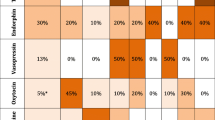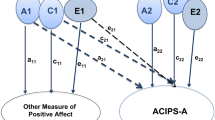Abstract
The role of simplifying assumptions for genetic models of personality was examined for three traits measured by the Differential Personality Questionnaire—Social Potency (dominance), Social Closeness, and Impulsivity. A new path model, the THETA model, is introduced and applied to summary correlations. Results suggest that assumptions about assortative mating, genetic dominance variance, equal environmental variance for identical twins, and sex differences were crucial for achieving satisfactory fits. Moreover, the assumptions important for one trait were not always important for another trait. If sampling bias in the correlations is minimal, then the genetic and environmental architecture of personality traits may be complex and trait specific.
Similar content being viewed by others
References
Carey, G., Goldsmith, H. H., Tellegen, A., and Gottesman, I. I. (1978). Genetics and personality inventories: The limits of replication with twin data.Behav. Genet. 6:299–313.
Cavalli-Sforza, L. L., and Feldman, M. W. (1978). Evolution of continuous variation. III. Joint transmission of genotype-phenotype and environment.Genetics 90:391–425.
Cloninger, C. R. (1980). Interpretation of intrinsic and extrinsic structural relations by path analysis: Theory and application to assortative mating.Genet. Res. Cambr. 36:133–145.
Cloninger, C. R., Rice, J., and Reich, T. (1979). Multifactorial inheritance with cultural transmission and assortative mating. II. A general model of combined polygenic and cultural inheritance.Am. J. Hum. Genet. 31:176–198.
Eaves, L. J. (1976). A model for sibling effects in man.Heredity 36:205–214.
Eaves, L. J., and Eysenck, H. J. (1975). The nature of extraversion: A genetical analysis.J. Personal. Soc. Psychol. 32:102–112.
Eaves, L. J., and Eysenck, H. J. (1976). Genetic and environmental components of inconsistency and unrepeatability in twins' responses to a neuroticism questionnaire.Behav. Genet. 6:145–160.
Eaves, L., and Young, P. A. (1981). Genetical theory and personality differences. In Lynn, R. (ed.),Dimensions of Personality: Papers in Honour of H. J. Eysenck, Pergamon Press, New York, pp. 129–179.
Eaves, L. J., Last, K., Martin, N. G., and Jinks, J. L. (1977). A progressive approach to non-additivity and genotype-environmental covariance in the analysis of human differences.Br. J. Math. Stat. Psychol. 30:1–42.
Eaves, L., Last, K. A., Young, P. A., and Martin, N. (1978). Model fitting approaches to the analysis of human behavior.Heredity 41:249–320.
Elston, R. C. (1975). On the correlations between correlations.Biometrics 63:133–140.
Falconer, D. S. (1960).Introduction to Quantitative Genetics, Oliver & Boyd, London.
Fulker, D. W. (1978). Multivariate extensions of a biometrical model of twin data. In Nance, W. (ed.),Twin Research: Psychology and Methodology, Alan R. Liss, New York, pp. 79–93.
Gottesman, I. I. (1963). Heritability of personality: A demonstration.Psychol. Monogr. 77 (Whole No. 572):1–21.
Gottesman, I. I. (1966). Genetic variance in adaptive personality traits.J. Child Psychol. Psychiatr. 7:199–208.
Grotevant, H. D., Scarr, S., and Weinberg, R. A. (1977). Patterns of interest similarity in adoptive and biological families.J. Personal. Soc. Psychol. 35:667–676.
Horn, J. M., Plomin, R., and Roseman, R. (1976). Heritability of personality traits in adult male twins.Behav. Genet. 6:17–30.
Jinks, J. L., and Fulker, D. W. (1970). Comparisons of the biometrical, genetical, MAVA, and classical approaches to the analysis of human behavior.Psychol. Bull. 73:311–349.
Kaplan, E. B., and Elston, R. C. (1972).A Subroutine Package for Maximum Likelihood Estimation (MAXLIK), Institute of Statistics, Mimeo Series No. 823, University of North Carolina, Chapel Hill.
Kempthorne, O. (1954). The correlation between relatives in a random mating population.Proc. Roy. Soc. Ser. B 143:103–113.
Lange, K., Westlake, J., and Spence, M. A. (1976). Extensions to pedigree analysis. III. Variance components by the scoring method.Ann. Hum. Genet. Lond. 39:485–491.
Loehlin, J. C. (1978). Heredity-environment analyses of Jencks's IQ correlations.Behav. Genet. 8:415–436.
Loehlin, J. C. (1982). Are personality traits differentially heritable?Behav. Genet. 12:417–428.
Loehlin, J. C., and Nichols, R. C. (1976).Heredity, Environment and Personality: A Study of 850 Sets of Twins, University of Texas Press, Austin.
Loehlin, J. C., Horn, J. M., and Willerman, L. (1981). Personality resemblance in adoptive families.Behav. Genet. 11:309–330.
Loehlin, J. C., Willerman L., and Horn, J. M. (1982). Personality resemblances between unwed mothers and their adopted-away offspring.J. Personal. Soc. Psychol. 42:1089–1099.
Lykken, D. T., Tellegen, A., and DeRubeis, R. (1978). Volunteer bias in twin research: The rule of two-thirds.Soc. Biol. 25:1–9.
Lytton, H. (1977). Do parents create, or respond to, differences in twins?Dev. Psychol. 13:456–459.
Nichols, R. C. (1966). The resemblance of twins in personality and interests.Natl. Merit Scholar. Corp. Res. Rep. 2:1–23.
Plomin, R., Willerman, L., and Loehlin, J. C. (1976). Resemblance in appearance and the equal environments assumption in twin studies of personality traits.Behav. Genet. 6:43–52.
Plomin, R., DeFries, J. C., and Loehlin, J. C. (1977). Gene-environment interaction and correlation in the analysis of human behavior.Psychol. Bull. 84:309–322.
Price, R. A., and Vandenberg, S. G. (1980). Spouse similarity in American and Swedish couples.Behav. Genet. 10:59–71.
Rao, D. C., Morton, N. E., and Yee, S. (1976). Resolution of cultural and biological inheritance by path analysis.Am. J. Hum. Genet. 28:228–242.
Rao, D. C., Morton, N. E., Elston, R. C., and Yee, S. (1977). Causal analysis of academic performance.Behav. Genet. 1:147–160.
Rice, J., Cloninger, C. R., and Reich, T. (1978). Multifactorial inheritance with cultural transmission and assortative mating. I. Description and basic properties of the unitary models.Am. J. Hum. Genet. 30:618–643.
Rice, J., Cloninger, C. R., and Reich, T. (1980). Analysis of behavioral traits in the presence of cultural transmission and assortative mating: Applications to IQ and SES.Behav. Genet. 10:73–92.
Scarr, S. (1968). Environmental bias in twin studies.Eugen. Quart. 15:34–40.
Scarr, S., Webber, P. L., Weinberg, R. A., and Wittig, M. A. (1981). Personality resemblance among adolescents and their parents in biologically related and adoptive families.J. Personal. Soc. Psychol. 40:885–898.
Shields, J. (1962).Monozygotic Twins Brought Up Apart and Together, University of Oxford Press, London.
Shields, J. (1978). MZA twins: Their use and abuse. In Nance, W. E. (ed.),Twin Research: Psychology and Methodology, Alan R. Liss, New York, pp. 79–93.
Tellegen, A. (1978).A Manual for the Differential Personality Questionnaire, Unpublished manuscript, University of Minnesota, Minneapolis.
Vandenberg, S. G. (1967). Hereditary factors in normal personality traits (as measured by inventories). In Wortis, J. (ed.),Recent Advances in Biological Psychiatry, Vol. 9, pp. 65–104.
Vandenberg, S. G., and Wilson, K. (1979). Failure of the twin situation to influence twin differences in cognition.Behav. Genet. 9:55–60.
Zonderman, A. B. (1982). Differential heritability and consistency: A Reanalysis of the NMSQT CPI data.Behav. Genet. 12:193–208.
Author information
Authors and Affiliations
Additional information
This work was supported in part by Grants MH-14647, MH-14677, MH-31302, MH-25430, and AA-03539.
Rights and permissions
About this article
Cite this article
Carey, G., Rice, J. Genetics and personality temperament: Simplicity or complexity?. Behav Genet 13, 43–63 (1983). https://doi.org/10.1007/BF01071743
Received:
Accepted:
Issue Date:
DOI: https://doi.org/10.1007/BF01071743




